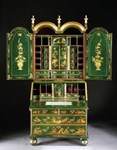
The ongoing discussion over the rights and wrongs of flying the Confederate flag or toppling statues of Stonewall Jackson and Robert Lee is proof enough that the past still lingers long in the present. Historic militaria – from the Revolutionary period to the Second World War – is a strong and strengthening market.
Revisionist history is retelling the stories Americans thought they knew. The opening in April of the Museum of the American Revolution in Philadelphia is shedding new light on the role of black people, women, privateers and loyalists in the struggle for independence. A series of events is also being planned for 2019 – the 400th anniversary of the arrival of African slaves in America.
Significant additions to decorative arts scholarship are also being made. The discovery of porcelain sherds during a dig at the site of John Bartlam kilns in Cain Hoy near Charleston early this century – and the subsequent emergence on the UK market of a handful of Cain Hoy tea bowls and saucers – was little short of a revelation. It brought forward the history of porcelain manufacture in North America by almost a decade.
It was followed last year by an article in the Chipstone Foundation’s annual American Furniture journal titled Thomas Johnson, Hercules Courtenay, and the Dissemination of London Rococo Design. It tells the story of Irish-born Hercules Courtenay (1736–1812), a London-trained carver who emigrated to Philadelphia armed with a copy of Johnson’s New Book of Ornaments.














